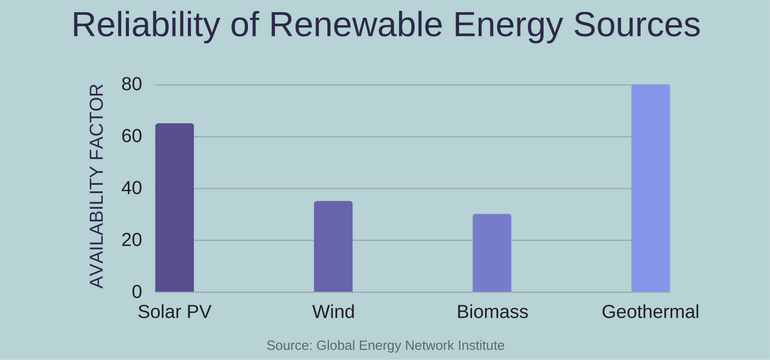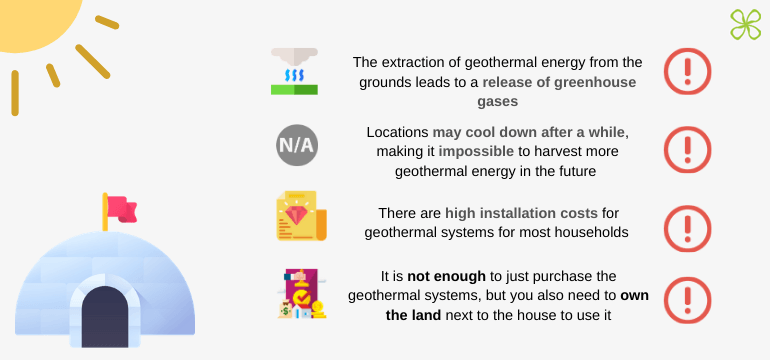Answer these simple questions and we will find you the BEST prices
Which type of solar quotes do you need?
It only takes 30 seconds
100% free with no obligation

Get up to 4 quotes from our selected suppliers by filling in only 1 form

Save money by comparing quotes and choosing the most competitive offer

Our service is 100% free and with no obligation
- GreenMatch
- Blog
- Advantages and Disadvantages of Geothermal Energy
Advantages and Disadvantages of Geothermal Energy - The Source of Renewable Heat
List of Pros & Cons of Geothermal Energy Production
Geothermal energy is currently believed to be one of the most advantageous sources of energy. Not only is it a renewable type of energy but is also present in most areas, outperforming even some conventional sources in many aspects.
The UK is even considering a construction of the world’s longest power connector between UK and Iceland, which would deliver more renewable energy to 1.6 million British homes that do not have geothermal heat pumps. Moreover, the first commercial geothermal power plant is planned to be built in Cornwall, UK if all the necessary funds are obtained.
That should come as no surprise since some countries profit from the presence of geothermal energy on a large scale. The most known case is Iceland whose electricity is 100% sustainable, making use of wind, hydro- and mostly geothermal energy.
Nevertheless, you don’t need a backyard the size of a football field in order to reduce your energy bills. In fact, more and more households all around the globe are investing in ground source heat pumps and heating systems to cut their costs.
What Are the Advantages of Geothermal Energy?
Geothermal energy has many advantages, especially when compared to conventional sources of energy:
1. Geothermal Energy Sourcing Is Good for the Environment
First and foremost, geothermal energy is extracted from the earth without burning fossil fuels, and geothermal fields produce practically no emissions. What’s more, geothermal energy can be very beneficial, as you can achieve savings of up to 80% over conventional energy usage.
2. Geothermal Is a Reliable Source of Renewable Energy
Geothermal energy also has many advantages when compared to other renewable sources like solar, wind or biomass. It is an exceptionally constant source of energy, meaning that it is not dependent on neither wind nor sun, and available all year long. This gives geothermal and advantage over solar panels.
When looking at the availability factor, which shows how reliable and constant specific energy sources are, geothermal is ranking on the top (see the figure below), way above the other groups, which supports the argument of its independence on inconstant external circumstances when delivering energy.
3. High Efficiency of Geothermal Systems
Geothermal heat pump systems use 25% to 50% less electricity than conventional systems for heating or cooling, and with their flexible design they can be adjusted to different situations, requiring less space for hardware as opposed to conventional systems.
4. Little to No Geothermal System Maintenance
Due to the fact that geothermal systems only have few movable parts which are sheltered inside a building, the life span of geothermal heat pump systems is relatively high. Heat pump pipes even have warranties of between 25 and 50 years, while the pump can usually last for at least 20 years.
Fill in the form in just 1 minute
Availability Factor of Geothermal Energy in Comparison to Other Renewables

What are the Disadvantages of Geothermal Energy?
However, there are always two sides of the coin so let’s have a look at the cons of geothermal energy:
1. Environmental Concerns about Greenhouse Emissions
Unfortunately, no matter its reputation of being an environmentally friendly alternative energy source, geothermal energy also causes some minor concerns in regards to the environment.
The extraction of geothermal energy from the grounds leads to a release of greenhouse gases like hydrogen sulfide, carbon dioxide, methane and ammonia. However, the amount of gas released is significantly lower than in the case of fossil fuels.
2. Possibility of Depletion of Geothermal Sources
Furthermore, despite being considered a sustainable and renewable energy, the chances are that specific locations might cool down after time, making it impossible to harvest more geothermal energy in future.
The only non-depletable option is sourcing geothermal energy right from magma but the technology for doing so is still in the process of development. This option is worth the investment mainly thanks to the fact that magma will be around for billions of years.
3. High Investment Costs for Geothermal System
Another disadvantage is the high initial cost for individual households. The need for drilling and installing quite a complex system into one’s home makes the price climb quite high. Nevertheless, the return on such investment is very promising, being able to earn the investment back within 2 to 10 years.
4. Land Requirements for Geothermal System to Be Installed
In case of geothermal systems, having a piece of land next to the house is required in order to be able to install one. That makes geothermal systems hard to be implemented for homeowners in big cities, unless a vertical ground source heat pump is used.

What Types of Geothermal Systems Are there?
There is a number of different geothermal systems available. Which system to choose depends on a variety of factors such as soil conditions, climate, local installation costs on site and available land. There are two basic ground loop systems which further divide into several subgroups:
- Horizontal
- Vertical
- Pond
- Pond
- Standing well
These systems differ mainly in the installation of the pipes, depending on the structure and size of the land available.
How Much Does a Geothermal Energy System Cost?
After all this information on the pros and cons of geothermal energy, the core question remains: how much do you actually have to invest in order to get your own geothermal system up and running in your own home?
As we have determined in one of our previous posts ‘Ground source heat pump prices,’ a geothermal ground source heat pump can cost from £13,000 to £20,000, whereas an air source heat pump hovers around £7,000-£11,000. This shows that air source heat pump costs can be much lower.
See approximate informative numbers on geothermal installation for a 100m² house:
| 100m² House | |
|---|---|
| Average Lifetime | 18-23 years |
| Payback Time | 2-10 years |
| Average Installation Cost | £15,000-£30,000 |
| Energy Bill Reduction | 40%-60% |
| Government Incentives | Up to 30% of total cost |
Even though geothermal systems are more costly compared to other heating or cooling systems, they have much lower operating costs and deliver more energy per unit.
Fill in the form in just 1 minute
Governmental Geothermal Grants
Incentives from the UK government or the community typically hover around 30% of the total price, making the implementation of geothermal systems highly competitive to conventional systems. It is believed that costs for the implementation are likely to be reduced further in the future.
The Domestic/Non-Domestic Renewable Heat Incentive (RHI) is a UK governmental financial incentive promoting the use of renewable heat. However, the amount of such aid depends on many factors, like the house size, location, roof type, current heating system, etc., and can be calculated online.
How and Where to Install a Geothermal System?
As the shallow ground temperatures from which geothermal energy is taken are relatively constant, geothermal heating systems can be used almost everywhere. However, the characteristics of the land decide which systems might be more favorable, and needs to be determined by your supplier and installer.
Aspects that influence the type of geothermal system to install:
Geology
Composition and properties of soil and rock can affect heat transfer rates and therefore need to be taken into consideration for designing geothermal systems.
Hydrology
Ground and surface water influence the type of ground loop, as well as groundwater can be used as a source for open-loop system, if the water quality is sufficient.
Land Availability
The size and layout of the land, landscaping, location of sprinkler systems, etc., determine the design of the geothermal system as well.
If you are interested in implementing a geothermal system, we can provide you with quotes and offers from up to four different suppliers of geothermal systems that will match your requirements. The only thing you have to do is fill in the form on top of the page, and you will be contacted with tailored offers. This service is completely free and without any obligation!
Fill in the form in just 1 minute
We strive to connect our customers with the right product and supplier. Would you like to be part of GreenMatch?

